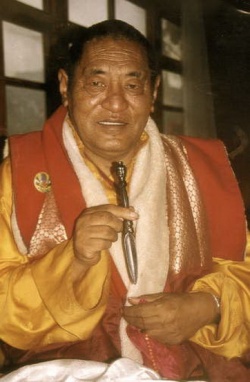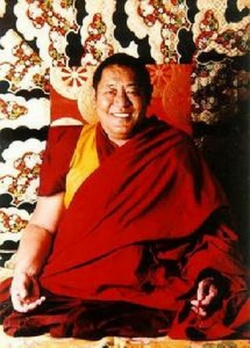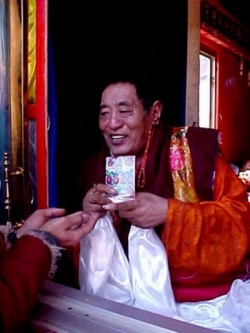Jigme Phuntsok
Khenpo Jigme Phuntsok (1933 – 2004) was a Nyingma lama from Golog. His family were nomads. At the age of two he was identified as the reincarnation of the Terton Sogyal, Lerab Lingpa (1852–1926). He studied Dzogchen at Nubzor Monastery, received novice ordination at 14, and full ordination at 22 (or 1955).
Khenpo Jigme Phuntsok was the most influential lama of the Nyingma tradition of Tibetan Buddhism in contemporary Tibet. A Tibetan Buddhist meditation master and renowned teacher of Great Perfection (Dzogchen), he established the Serthar Buddhist Institute in 1980, known locally as Larung Gar, a non-sectarian study center with approximately 10,000 monks, nuns, and lay students at its highest count. He played an important role in revitalizing the teaching of Tibetan Buddhism following the liberalization of religious practice in 1980.
Khenpo Jigme Phuntsok was also an extraordinary Terton (Buddhist treasure revealer), uncovering many treasures texts in Tibet, as well as other parts of China, and India. In the 1990s, he began an appeal to traditional Tibetan yak herders to refrain from commercial sale of their livestock for spiritual and cultural reasons that has grown into the Anti-Slaughter Movement.
Biography
Khenpo Jigme Phuntsok was born in 1933, the third day of the first month of the year of the Water Bird, in Golog, Amdo of Tibet, or the rugged washul Sertar region of the Tibetan cultural region of Kham, a vast expanse of high-plateau grasslands. He adopted Manjusri as his personal deity and he is said to have had visions of him several times, including once in 1987 when he visited Mount Wutai, the holy mountain abode of Manjushri in China. At the age of five, Khenpo was recognized as the reincarnate of Terton Sogyal, guru to the 13th Dalai Lama Thubten Gyatsho, and became a monk at Nubzur Gonpa, a branch of the Palyul monastery in Sertar. He received formal religious training under Thubga Rinpoche at Changma Rithro in Dzachukha and was selected to become abbot of Nubzur at the age of twenty-four. From the rise of the People's Republic of China, Khenpo’s religious career was greatly curtailed, to the point in 1959 he withdrew into the remote mountains, herding a small flock of goats and sheep. There he engaged in meditation and teaching to small numbers of people and was able to continue his religious practice. In 1987, Khenpo led hundreds of his disciples from Serthar Institute on a pilgrimage to the sacred mountains of Mount Wutai in China's Shaanxi Province. En route in Beijing, he met the 10th Panchen Lama and gave teachings on the 37 Practices of Bodhisattvas to a congregation of over 5,000 people, including Tibetan Chinese, Han Chinese, Mongol Chinese, and other Buddhist practitioners. At Mount Wutai, the congregation for his teachings swelled to10,000 on occasions. He also undertook retreats at sacred locations and caves.
Khenpo made extensive travels across Tibet and the rest of China teaching Nyingma traditional Buddhism and rediscovering hidden treasures. In 1990, at the invitation of Penor Rinpoche, he visited India, where he taught at various monasteries, including the Nyingma Institute in Mysore. At Dharamsala, the 14th Dalai Lama received teachings from Khenpo for two weeks. In 1993, Khenpo was invited[by whom?] to tour and teach at Buddhist centers in Europe and North America. There, he became disillusioned with the commercialization of Buddhist teachings in the West. In 1993, Khenpo Jigme Phuntsok expanded his following during teaching tours of the United States, Canada, Germany, England, France, Japan, Taiwan, Hong Kong, India, Nepal, and Bhutan. Financial offerings made to him during this tour funded a major building program at the institute. On December 29, 2003, at age 70, Khenpo Jigme Phuntsok was admitted to the Military Hospital 363 in Chengdu, the capital of China’s Sichuan province, with heart problems, and died there on January 7, 2004.
Buddhist Institute
In 1980, Khenpo Jigme Phuntsok founded Serthar Institute, known as Larung Gar Buddhist Academy, in the Larung Valley near the town of Sêrtar, Garzê Prefecture, Sichuan Province. The purpose of the Institute has been to provide an ecumenical training in Tibetan Buddhism and to meet the need for renewal of meditation and scholarship all over Tibet in the wake of China’s Cultural Revolution of 1966-76.
Despite its remote location, it grew from a handful of disciples gathering in Khenpo's home to be one of the largest and most influential centers for the study of Tibetan Buddhism in the world, numbering to nearly 10,000 monks, nuns, and lay disciples by the year 2000.
Overall, the student body of Serthar Institute was made up of monks, nuns, lay "vow-holders" of both Tibetan and Chinese origins, and tantric practitioners. They studied under four major religious divisions in the Institute: Ngarig Nangten Lobling, International Religious Committee, Pema Khandro Duling Nunnery, and Lektso Charbeb Ling. Ngarig Nangten Lobling consisted of 2,500 Tibetan monks. Lektso Charbeb Ling is the section that trained over 1,000 lay Tibetan "vow-holders" and tantric practitioners from Sêrtar and other regions of Tibet.
Pema Khandro Duling Nunnery was the home for study to approximately 3,500-4,000 nuns from all regions of Tibet. More than half of those who came to Serthar were women and the curriculum allowed nuns to achieve a coveted Khenpo degree for the first time in Tibetan history. Entry into the relatively small number of nunneries that exist in other areas of Tibet is limited, but Serthar was open to virtually anyone who genuinely sought to become a student of Khenpo Jigme Phuntsok’s ecumenical vision. Khenpo’s niece, Jetsunma Mumso, was recognized as a tulku and heads the order of nuns. The term is descriptive of certain teachers in Tibet who are thought to reincarnate over a number of generations.
Roughly ten percent of the nearly 10,000 students attending Serthar were ethnic Han people. They attended separate classes taught in Standard Chinese while larger classes were taught in Standard Tibetan. The International Religious Committee oversaw 1,000 disciples from regions of the People’s Republic of China and students from other Asian countries.
Serthar Institute has operated with a standing executive committee of seven learned lamas, but major decisions were confirmed and implemented only after consultation with Khenpo Jigme Phuntsok. Serthar Institute has been home to over 500 khenpos—holders of Bachelor's degrees in divinity—and widely renowned for the high quality of both its religious and secular education. English, Chinese, and Tibetan languages and modern computer studies have been taught alongside traditional non-sectarian Buddhist curriculum.
Terma
“Terma” is a Tibetan term that means “treasures” and consists of ancient Buddhist texts, objects for ritual, such as statues, or chests that may have been concealed by Padmasambhava or Buddhist master. Uncovering Terma is a very important tradition of the Nyingma sect of Tibetan Buddhism.
In modern Tibet, Khenpo Jigme Phuntsok was an intellectual and religious scholar as well as a famous Terton(treasure revealer). There are many mythic and charismatic stories of his ability to uncover Terma. In 1990, he discovered a sacred site that had been a palace of legendary King Gesar. That led to an archaeological dig that turned up ancient building stones and several treasure chests. His findings of new sacred sites and caves that related to previous Buddha and reincarnations are numerous in Tibet. He also found holy places in other parts of world. During his visit to Mount Wutai in China and India, by miraculous signs he recalled memories of previous lives and discovered meditation retreat sites that were previously unknown. Khenpo Jigme Phuntsok’s ability to uncover Terma has played an important role in inspiring devotion in the revival of Tibetan Buddhism in contemporary Tibet.
Anti-slaughter movement
Khenpo Jigme Phuntsok first started the Anti-Slaughter Movement in the 1990s, after seeing an increase in the slaughter rate of livestock from Tibetan households and in the way that livestock suffered in transportation to domestic Chinese markets. As a religious teacher, he requested traditional herders to reduce their sale of livestock to commercial markets or to stop altogether. His students and many other lamas made similar appeals to herders to refrain from selling their livestock for commercial slaughter. Large numbers of herders responded by taking an oath to stop for a period of three years (or forever). Today, the practice of herders vowing to refrain from commercial activity with their yak herds has built into a movement that began in Sertha and spread to the larger geographical areas of the Eastern Tibetan Plateau and into the ethnic Tibetan pastoral areas of Sichuan, Qinghai, Gansu, and Tibet Autonomous Region (TAR).
Relations with the government
During the 1959 Tibetan Rebellion he made the crucial decision to remain in China rather than flee to India. Between 1960 and 1980 he returned to a nomadic lifestyle in order to avoid the Cultural Revolution.
In 1980 Jigme Phuntsok founded the Serthar Buddhist Institute (also called the Larung Gar Buddhist Institute, near the town of Sêrtar (Chinese Seda). The Institute's popularity grew until there were 8500 students at the site, including about 1000 ethnic Chinese as well as students from Taiwan, Hong Kong, Singapore, and Malaysia.
In 1987 Jigme Phuntsok met and befriended the Ninth Panchen Lama. In 1989 he also met the 14th Dalai Lama, whom he refused to denounce for the Lama's separatist activities. After this the Chinese government refused him permission to travel for any reason.
Around 1999 the Sichuan United Work Front pressed him on the issue of his support for the Dalai Lama, and demanded that he reduce the number of students at the Institute (either to 150 or to 1400, depending on reports). Jigme Phuntsok refused. In summer of 2001 several thousand members of the People's Armed Police and the Public Security Bureau descended on the site, razing its structures and dispersed its students.[citation needed]
Khenpo Jigme Phuntsok died of heart failure in 2004, at the age of 70 in Tibet.


